In Vitro Effect of Epigallocatechin Gallate on Heme Synthesis Pathway and Protoporphyrin IX Production
Abstract
1. Introduction
2. Results
2.1. EGCG at Low Concentrations Does Not Have an Antiproliferative Effect over A-431 Cells; However, It Inhibits Their Clonogenic Capability
2.2. Low EGCG Concentrations Improve PDT Cytotoxicity, Increasing PpIX and ROS Levels in A-431 Cells
2.3. EGCG Exerts Positive Influence on PpIX Synthesis
3. Discussion
3.1. Effect of EGCG on A-431 Cell Proliferation and ROS Generation
3.2. EGCG Positively Influences PpIX Synthesis and Improves PDT for Resistant Cells
4. Materials and Methods
4.1. Cell Culture
4.2. Reagents Preparation
4.3. MTT Assay
4.4. EC50 of EGCG Assay
4.5. Proliferation Assay
4.6. Wound Healing Assay
4.7. Clonogenic Assay
4.8. In Vitro MAL-PDT
4.9. PpIX and Total ROS Detection
4.10. Gene Expression Analysis
4.11. Iron Quantification Assay
4.12. Statistical Analysis
5. Patents
Author Contributions
Funding
Institutional Review Board Statement
Informed Consent Statement
Data Availability Statement
Acknowledgments
Conflicts of Interest
References
- World Health Organization. Ultraviolet Radiation and the INTERSUN Programme; World Health Organization: Geneva, Switzerland, 2013. [Google Scholar]
- Gupta, A.; Paquet, M.; Villanueva, E.; Brintnell, W. Interventions for Actinic Keratoses (Review). Cochrane Database Syst. Rev. 2012, 12. [Google Scholar] [CrossRef]
- Bath-Hextall, F.; Matin, R.; Wilkinson, D.; Leonardi-Bee, J. Interventions for Cutaneous Bowen’ s Disease. Cochrane Database Syst. Rev. 2013, 6. [Google Scholar] [CrossRef]
- Berman, B.; Amini, S. Pharmacotherapy of Actinic Keratosis: An Update. Expert Opin. Pharmacother. 2012, 13, 1847–1871. [Google Scholar] [CrossRef] [PubMed]
- Morton, C.A.; Szeimies, R.-M.; Sidoroff, A.; Braathen, L.R. European Guidelines for Topical Photodynamic Therapy Part 1: Treatment Delivery and Current Indications–Actinic Keratoses, Bowen’s Disease, Basal Cell Carcinoma. J. Eur. Acad. Dermatol. Venereol. 2013, 27, 536–544. [Google Scholar] [CrossRef] [PubMed]
- Li, Q.; Gao, T.; Jiao, B.; Hu, X.; Luan, Q.; Li, K.; Ma, C.; Li, C.; Wang, S. Tumor Thickness Predicts Long-Term Complete Response of Facial Basal Cell Carcinomas in Asian Skin Types Iv/v Treated with Methyl Aminolaevulinate Photodynamic Therapy. Photomed. Laser Surg. 2011, 29, 501–507. [Google Scholar] [CrossRef] [PubMed]
- Huang, Y.-Y.; Vecchio, D.; Avci, P.; Yin, R.; Garcia-Diaz, M.; Hamblin, M.R. Melanoma Resistance to Photodynamic Therapy: New Insights. Biol. Chem. 2013, 394, 239–250. [Google Scholar] [CrossRef] [PubMed]
- Lucena, S.R.; Salazar, N.; Gracia-Cazaña, T.; Zamarrón, A.; González, S.; Juarranz, Á.; Gilaberte, Y. Combined Treatments with Photodynamic Therapy for Non-Melanoma Skin Cancer. Int. J. Mol. Sci. 2015, 16, 25912–25933. [Google Scholar] [CrossRef] [PubMed]
- O’Connor, A.E.; Gallagher, W.M.; Byrne, A.T. Porphyrin and Nonporphyrin Photosensitizers in Oncology: Preclinical and Clinical Advances in Photodynamic Therapy. Photochem. Photobiol. 2009, 85, 1053–1074. [Google Scholar] [CrossRef] [PubMed]
- Fiorito, V.; Allocco, A.L.; Petrillo, S.; Gazzano, E.; Torretta, S.; Marchi, S.; Destefanis, F.; Pacelli, C.; Audrito, V.; Provero, P.; et al. The Heme Synthesis-Export System Regulates the Tricarboxylic Acid Cycle Flux and Oxidative Phosphorylation. Cell Rep. 2021, 35, 109252. [Google Scholar] [CrossRef]
- Cavicchini, S.; Serini, S.M.; Fiorani, R.; Girgenti, V.; Ghislanzoni, M.; Sala, F. Long-Term Follow-up of Metil Aminolevulinate (MAL)-PDT in Difficult-to-Treat Cutaneous Bowen’s Disease. Int. J. Dermatol. 2011, 50, 1002–1005. [Google Scholar] [CrossRef]
- Casas, A.; Di Venosa, G.; Hasan, T. Al Batlle Mechanisms of Resistance to Photodynamic Therapy. Curr. Med. Chem. 2011, 18, 2486–2515. [Google Scholar] [CrossRef] [PubMed]
- Du, G.; Zhang, Z.; Wen, X.; Yu, C.; Calway, T.; Yuan, C.; Wang, C. Epigallocatechin Gallate (EGCG) Is the Most Effective Cancer Chemopreventive Polyphenol in Green Tea. Nutrients 2012, 41, 1679–1691. [Google Scholar] [CrossRef] [PubMed]
- Shuang, S.; Ye-Wei, H.; Yang, T.; Xuan-Jun, W.; Jun, S. Mechanism of Action of (−)-Epigallocatechin-3-Gallate: Auto-Oxidation-Dependent Activation of Extracellular Signal-Regulated Kinase 1/2 in Jurkat Cells. Chin. J. Nat. Med. 2014, 12, 654–662. [Google Scholar] [CrossRef]
- Krupkova, O.; Ferguson, S.J.; Wuertz-kozak, K. Stability of (−)-Epigallocatechin Gallate and Its Activity in Liquid Formulations and Delivery Systems. J. Nutr. Biochem. 2016, 37, 1–12. [Google Scholar] [CrossRef] [PubMed]
- Min, K.; Kwon, T.K. Anticancer Effects and Molecular Mechanisms of Epigallocatechin-3-Gallate. Integr. Med. Res. 2014, 3, 16–24. [Google Scholar] [CrossRef] [PubMed]
- Qi, H.; Abe, N.; Zhu, B.; Murata, Y.; Nakamura, Y. (−)-Epigallocatechin-3-Gallate Ameliorates Photodynamic Therapy Responses in an in Vitro T Lymphocyte Model. Phyther. Res. 2014, 28, 1486–1491. [Google Scholar] [CrossRef] [PubMed]
- Mun, S.T.; Bae, D.H.; Ahn, W.S. Epigallocatechin Gallate with Photodynamic Therapy Enhances Anti-Tumor Effects In Vivo and In Vitro. Photodiagn. Photodyn. Ther. 2014, 11, 141–147. [Google Scholar] [CrossRef] [PubMed]
- Ferrario, A.; Luna, M.; Rucker, N.; Wong, S.; Gomer, C.J. Pro-Apoptotic and Anti-Inflammatory Propierties of the Green Tea Constituent Epigallocatechin Gallate Increase Photodynamyc Therapy Resposiveness. Lasers Surg. Med. 2011, 43, 644–650. [Google Scholar] [CrossRef] [PubMed][Green Version]
- Sahadevan, R.; Binoy, A.; Vechalapu, S.; Nanjan, P.; Sadhukhan, S. In Situ Global Proteomics Profiling of EGCG Targets Using a Cell- Permeable and Click-Able Bioorthogonal Probe. Int. J. Biol. Macromol. 2023, 2, 33–47. [Google Scholar] [CrossRef]
- Kim, H.; Quon, M.J.; Kim, J. New Insights into the Mechanisms of Polyphenols beyond Antioxidant Properties; Lessons from the Green Tea Polyphenol, Epigallocatechin 3-Gallate. Redox Biol. 2014, 2, 187–195. [Google Scholar] [CrossRef]
- Zhang, Y.; Yang, N.D.; Zhou, F.; Shen, T.; Duan, T.; Zhou, J.; Shi, Y.; Zhu, X.Q.; Shen, H.M. (−)-Epigallocatechin-3-Gallate Induces Non-Apoptotic Cell Death in Human Cancer Cells via ROS-Mediated Lysosomal Membrane Permeabilization. PLoS ONE 2012, 7, e046749. [Google Scholar] [CrossRef] [PubMed]
- Li, W.; Zhu, S.; Li, J.; Assa, A.; Jundoria, A.; Xu, J.; Fan, S.; Eissa, N.T.; Tracey, K.J.; Sama, A.E.; et al. EGCG Stimulates Autophagy and Reduces Cytoplasmic HMGB1 Levels in Endotoxin-Stimulated Macrophages. Biochem. Pharmacol. 2011, 81, 1152–1163. [Google Scholar] [CrossRef] [PubMed]
- Lambert, J.D.; Elias, R.J. The Antioxidant and Pro-Oxidant Activities of Green Tea Polyphenols: A Role in Cancer Prevention. Arch. Biochem. Biophys. 2010, 501, 65–72. [Google Scholar] [CrossRef] [PubMed]
- Giretti, M.S.; Guevara, M.M.M.; Cecchi, E.; Mannella, P.; Palla, G.; Spina, S.; Bernacchi, G.; Di Bello, S.; Genazzani, A.R.; Genazzani, A.D.; et al. Effects of Estetrol on Migration and Invasion in T47-D Breast Cancer Cells through the Actin Cytoskeleton. Front. Endocrinol. 2014, 5, 80. [Google Scholar] [CrossRef]
- Latifi-Pupovci, H.; Kuçi, Z.; Wehner, S.; Bönig, H.; Lieberz, R.; Klingebiel, T.; Bader, P.; Kuçi, S. In Vitro Migration and Proliferation (“wound Healing”) Potential of Mesenchymal Stromal Cells Generated from Human CD271+ Bone Marrow Mononuclear Cells. J. Transl. Med. 2015, 13, 315. [Google Scholar] [CrossRef]
- Luo, K.W.; Chen, W.; Lung, W.Y.; Wei, X.Y.; Cheng, B.H.; Cai, Z.M.; Huang, W.R. EGCG Inhibited Bladder Cancer SW780 Cell Proliferation and Migration Both In Vitro and In Vivo via Down-Regulation of NF-ΚB and MMP-9. J. Nutr. Biochem. 2017, 41, 56–64. [Google Scholar] [CrossRef] [PubMed]
- Jiang, S.; Huang, C.; Zheng, G.; Yi, W.; Wu, B.; Tang, J.; Liu, X.; Huang, B.; Wu, D.; Yan, T.; et al. EGCG Inhibits Proliferation and Induces Apoptosis through Downregulation of SIRT1 in Nasopharyngeal Carcinoma Cells. Front. Nutr. 2022, 9, 851972. [Google Scholar] [CrossRef] [PubMed]
- Kim, E.; Han, S.Y.; Hwang, K.; Kim, D.; Kim, E.M.; Hossain, M.A.; Kim, J.H.; Cho, J.Y. Antioxidant and Cytoprotective Effects of (−)-Epigallocatechin-3-(3″-o-Methyl) Gallate. Int. J. Mol. Sci. 2019, 20, 3993. [Google Scholar] [CrossRef]
- Hsu, S.; Bollag, W.B.; Lewis, J.; Huang, Q.; Singh, B.; Sharawy, M.; Yamamoto, T.; Schuster, G. Green Tea Polyphenols Induce Differentiation and Proliferation in Epidermal Keratinocytes. J. Pharmacol. Exp. Ther. 2003, 306, 29–34. [Google Scholar] [CrossRef]
- Xu, F.W.; Lv, Y.L.; Zhong, Y.F.; Xue, Y.N.; Wang, Y.; Zhang, L.Y.; Hu, X.; Tan, W.Q. Beneficial Effects of Green Tea EGCG on Skin Wound Healing: A Comprehensive Review. Molecules 2021, 26, 6123. [Google Scholar] [CrossRef]
- Aggarwal, V.; Tuli, H.S.; Tania, M.; Srivastava, S.; Ritzer, E.E.; Pandey, A.; Aggarwal, D.; Barwal, T.S.; Jain, A.; Kaur, G.; et al. Molecular Mechanisms of Action of Epigallocatechin Gallate in Cancer: Recent Trends and Advancement. Semin. Cancer Biol. 2020, 80, 256–275. [Google Scholar] [CrossRef]
- Josefsen, L.B.; Boyle, R.W. Photodynamic Therapy: Novel Third-Generation Photosensitizers One Step Closer? Br. J. Pharmcol. 2008, 154, 1–3. [Google Scholar] [CrossRef]
- Youle, R.; Strasser, A. The BCL-2 Protein Family: Opposing Activities That Mediate Cell Death. Nat. Rev. Mol. Cell Biol. 2008, 9, 47–59. [Google Scholar] [CrossRef] [PubMed]
- Shiozaki, E.; Shi, Y. Caspases, IAPs and Smac/DIABLO: Mechanisms from Structural Biology. Trends Biochem. Sci. 2004, 29, 486–494. [Google Scholar] [CrossRef]
- León, D.; Buchegger, K.; Silva, R.; Riquelme, I.; Viscarra, T.; Mora-Lagos, B.; Zanella, L.; Schafer, F.; Kurachi, C.; Roa, J.C.; et al. Epigallocatechin Gallate Enhances MAL-PDT Cytotoxic Effect on PDT-Resistant Skin Cancer Squamous Cells. Int. J. Mol. Sci. 2020, 21, 3327. [Google Scholar] [CrossRef] [PubMed]
- Orisakwe, O.E.; Amadi, C.N.; Frazzoli, C. Management of Iron Overload in Resource Poor Nations: A Systematic Review of Phlebotomy and Natural Chelators. J. Toxicol. 2020, 2020, 4084538. [Google Scholar] [CrossRef]
- Li, D.; Cao, D.; Cui, Y.; Sun, Y. The Potential of Epigallocatechin Gallate in the Chemoprevention and Therapy of Hepatocellular Carcinoma. Front. Pharmacol. 2023, 14, 1201085. [Google Scholar] [CrossRef]
- Mechanisms, B. Reading the Tea Leaves: Anticarcinogenic Properties of (−)-Epigallocatechin-3-Gallate. Mayo Clin. Proc. 2007, 55987, 725–732. [Google Scholar] [CrossRef]
- Botten, D.; Fugallo, G.; Fraternali, F.; Molteni, C. Structural Properties of Green Tea Catechins. J. Phys. Chem. B 2015, 119, 12860–12867. [Google Scholar] [CrossRef]
- An, Z.; Qi, Y.; Huang, D.; Gu, X.; Tian, Y.; Li, P.; Li, H.; Zhang, Y. EGCG Inhibits Cd2+-Induced Apoptosis through Scavenging ROS Rather than Chelating Cd2+ in HL-7702 Cells. Toxicol. Mech. Methods 2014, 24, 259–267. [Google Scholar] [CrossRef]
- Farhan, M. Green Tea Catechins: Nature’ s Way of Preventing and Treating Cancer. Int. J. Mol. Sci. 2022, 23, 10713. [Google Scholar] [CrossRef] [PubMed]
- Alam, M.; Ali, S.; Ashraf, G.; Bilgrami, A.L.; Kumar, D.; Hassan, I. Epigallocatechin 3-Gallate: From Green Tea to Cancer Therapeutics. Food Chem. 2022, 379, 132135. [Google Scholar] [CrossRef] [PubMed]
- Nesran, Z.N.; Shafie, N.H.; Tohid, S.F.; Norhaizan, M.E.; Ismail, A. Iron Chelation Properties of Green Tea Epigallocatechin-3-Gallate (EGCG) in Colorectal Cancer Cells: Analysis on Tfr/Fth Regulations and Molecular Docking. Evid.-Based Complement. Altern. Med. 2020, 2020, 7958041. [Google Scholar] [CrossRef] [PubMed]
- Nesran, M.; Nameyra, Z. Role of Epigallocatechin-3-Gallate from Green Tea in Iron Chelation and Endoplasmic Reticulum Stress Pathway in Colorectal Cancer Cells. Master’s Thesis, Universiti Putra Malaysia, Serdang, Malaysia, 2018. [Google Scholar]
- Inoue, K.; Fukuhara, H.; Yamamoto, S.; Karashima, T.; Kurabayashi, A.; Furihata, M.; Hanazaki, K.; Lai, H.W. Current Status of Photodynamic Technology for Urothelial Cancer. Cancer Sci. 2022, 113, 392–398. [Google Scholar] [CrossRef] [PubMed]
- Fukuhara, H.; Inoue, K.; Kurabayashi, A.; Shuin, T. The Inhibition of Ferrochelatase Enhances 5-Aminolevulinic Acid-Based Photodynamic. Photodiagn. Photodyn. Ther. 2013, 10, 399–409. [Google Scholar] [CrossRef] [PubMed]
- Inoue, K.; Fukuhara, H.; Kurabayashi, A.; Furihata, M.; Tsuda, M.; Nagakawa, K. Photodynamic Therapy Involves an Antiangiogenic Mechanism and Is Enhanced by Ferrochelatase Inhibitor in Urothelial Carcinoma. Cancer Sci. 2013, 104, 765–772. [Google Scholar] [CrossRef] [PubMed]
- Safi, R.; Mohsen-kanson, T.; Nemer, G.; Dekmak, B.; Rubeiz, N.; El-sabban, M.; Nassar, D.; Eid, A.; Abbas, O.; Kibbi, A.; et al. Loss of Ferrochelatase Is Protective against Colon Cancer Cells: Ferrochelatase a Possible Regulator of the Long Noncoding RNA H19. J. Gastrointest. Oncol. 2020, 10, 859–868. [Google Scholar] [CrossRef]
- Livak, K.J.; Schmittgen, T.D. Analysis of Relative Gene Expression Data Using Real-Time Quantitative PCR and the 2(-Delta Delta C(T)) Method. Methods 2001, 408, 402–408. [Google Scholar] [CrossRef]

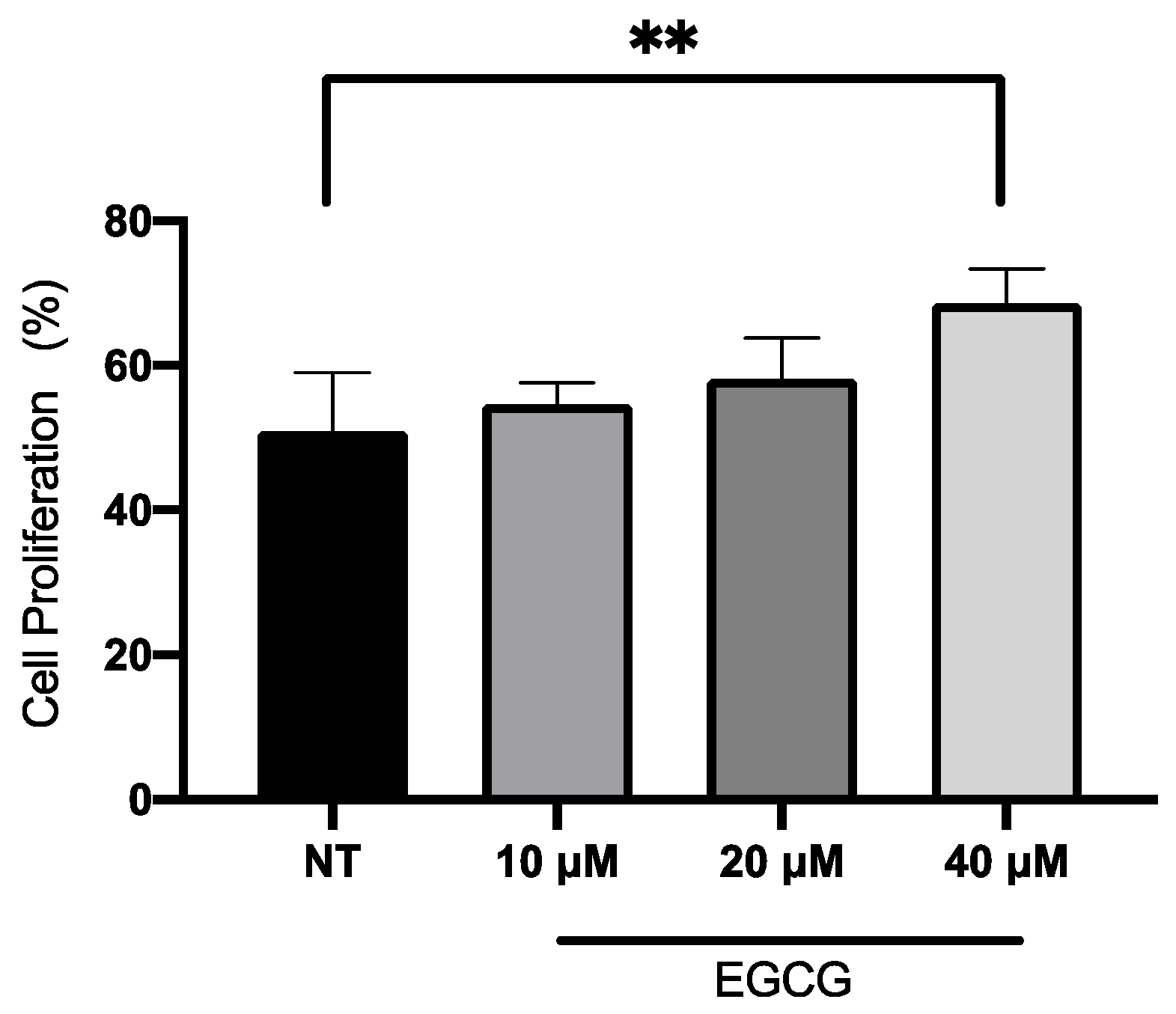
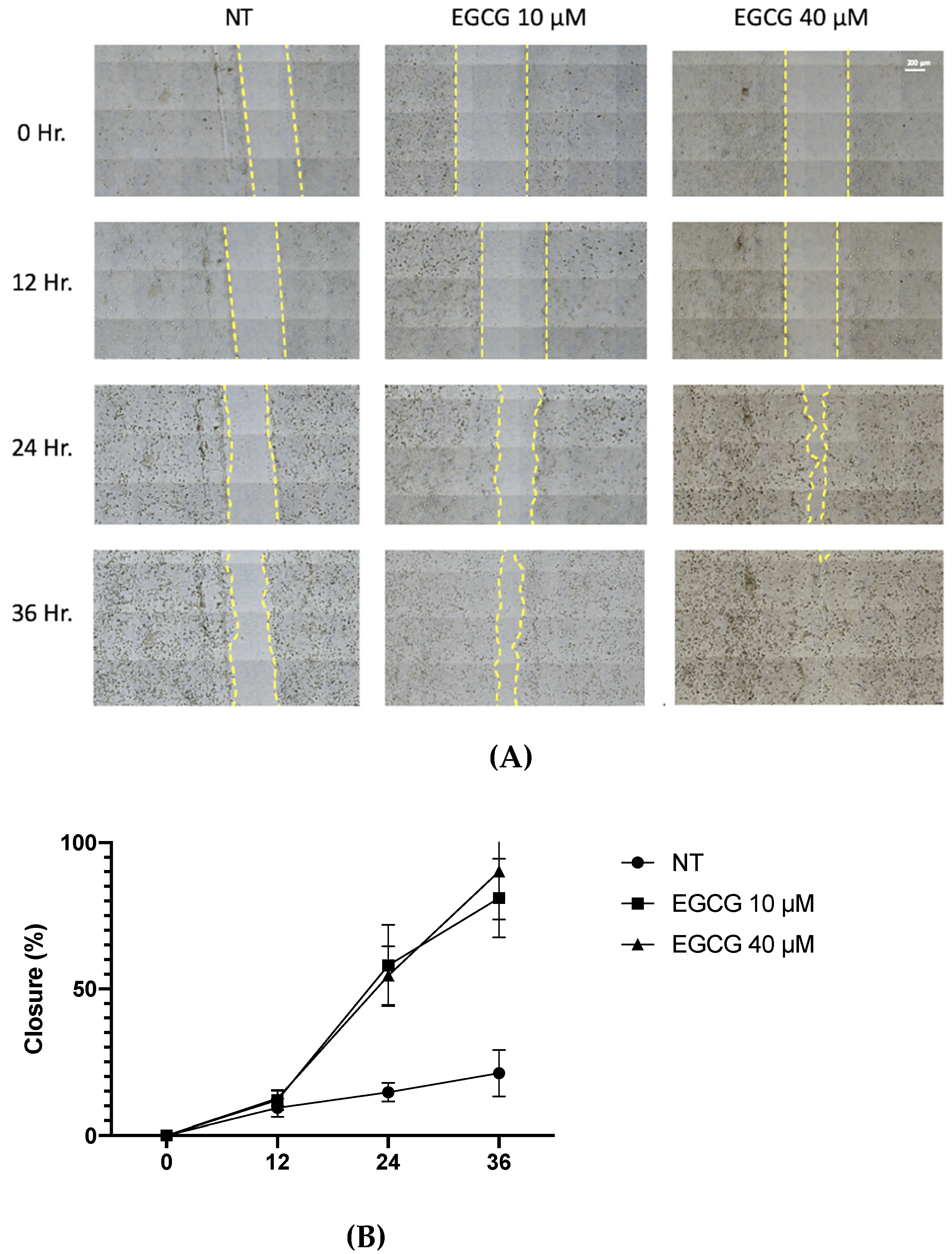
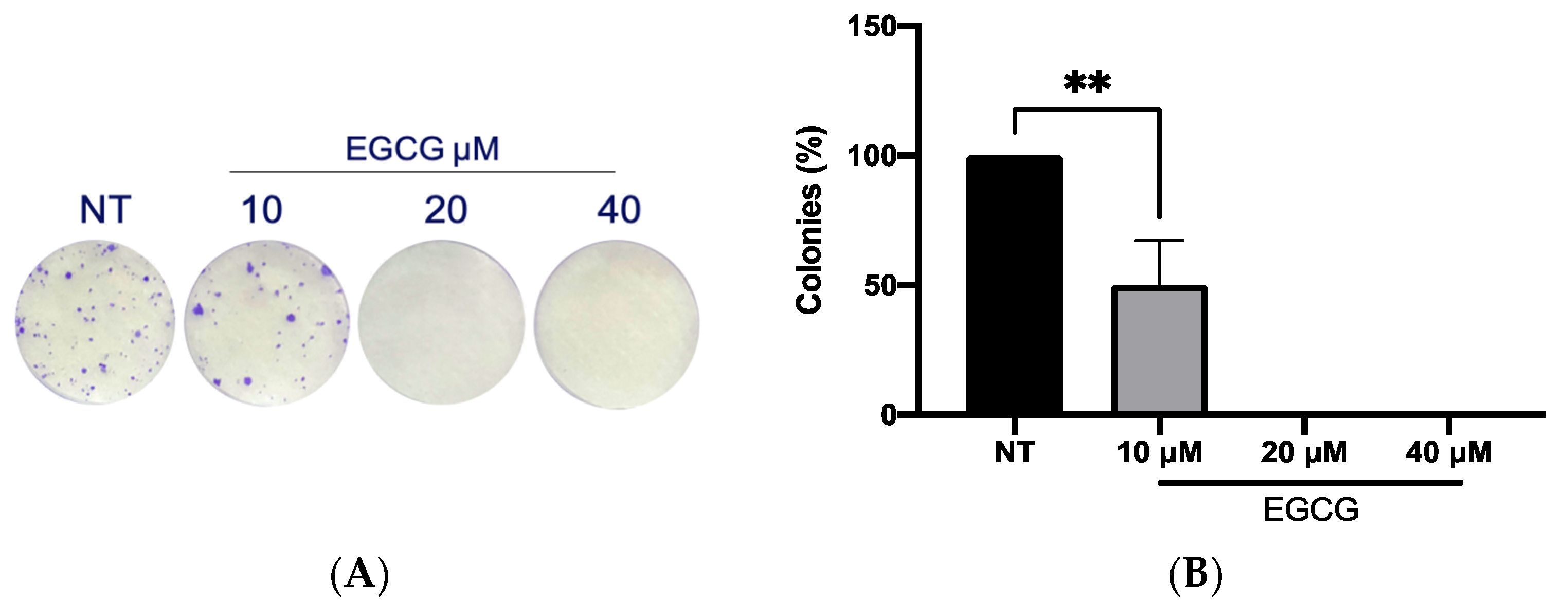
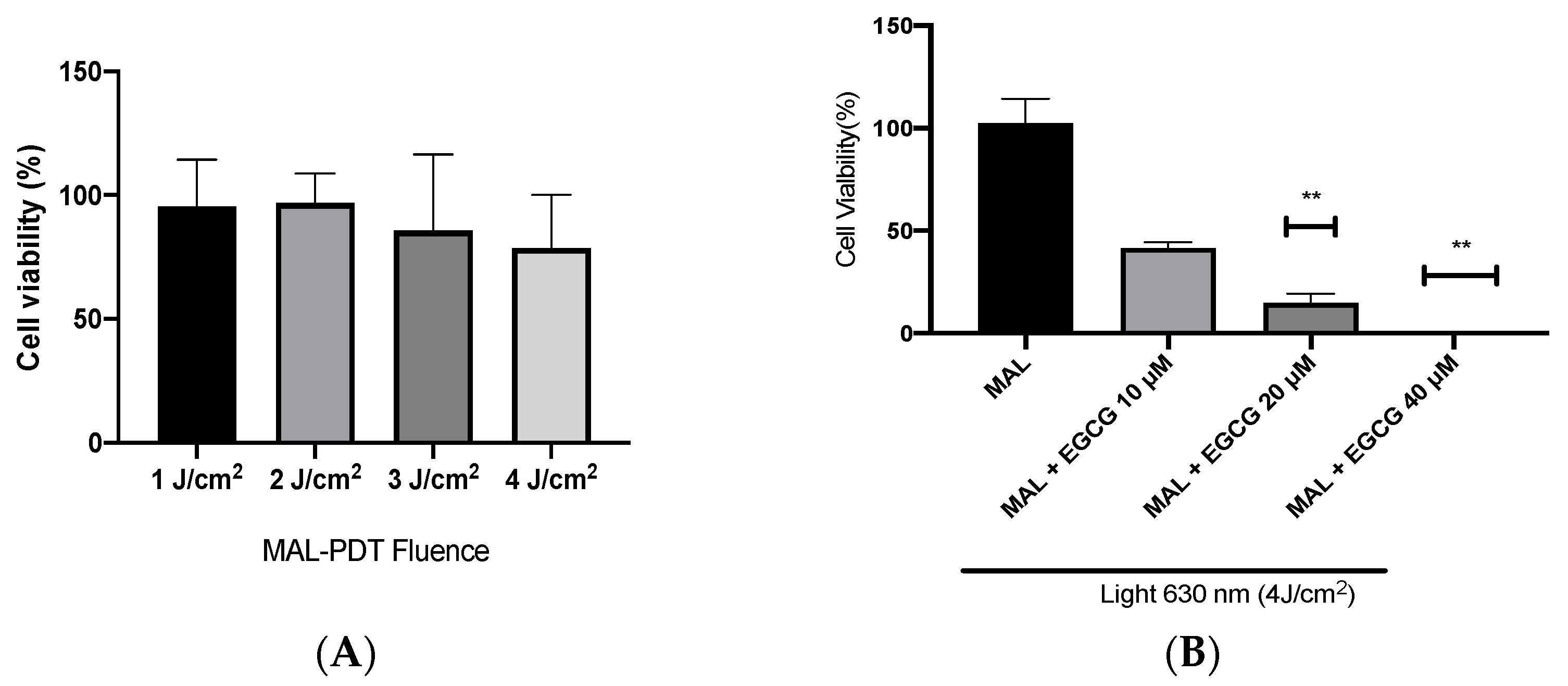

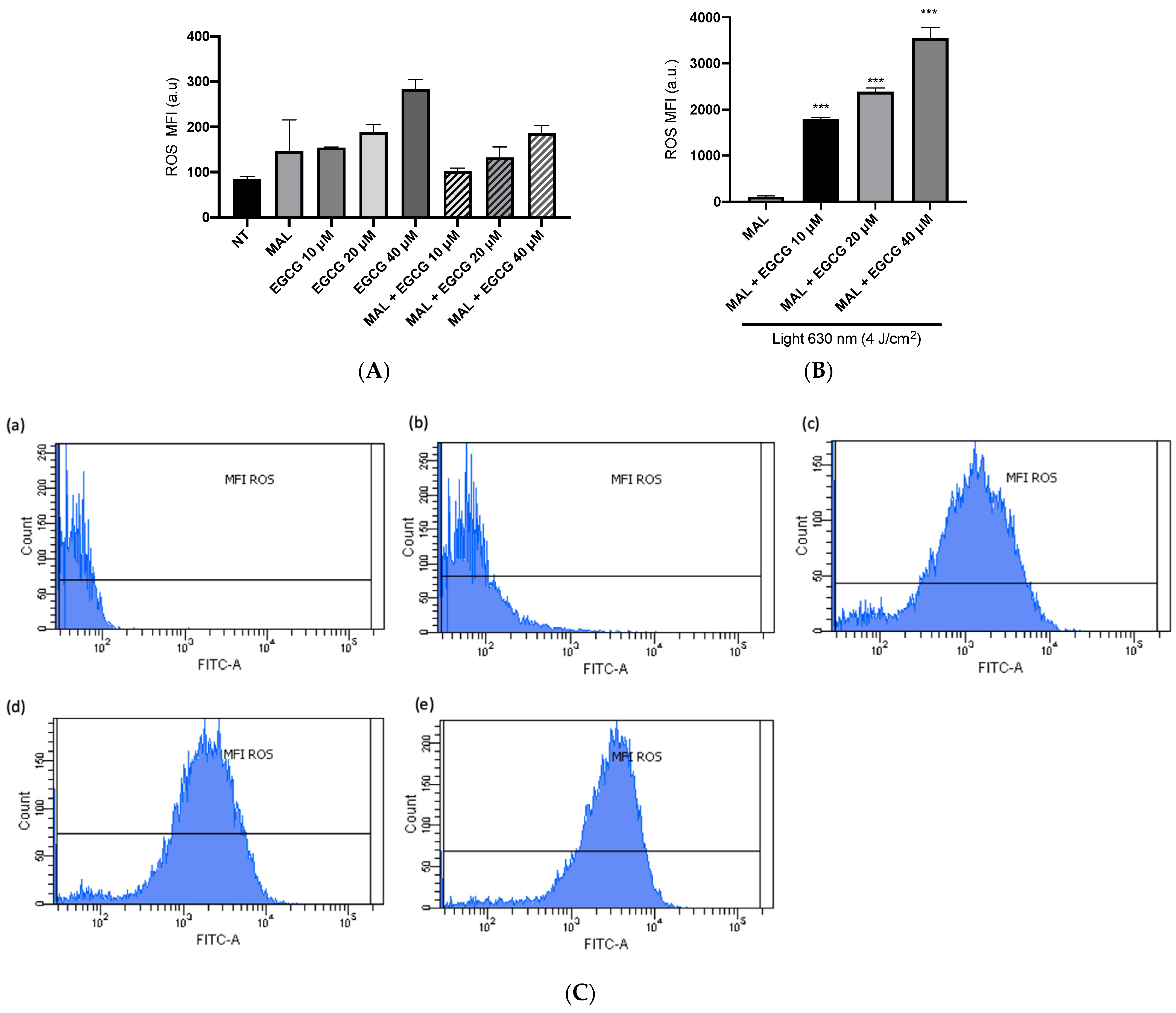
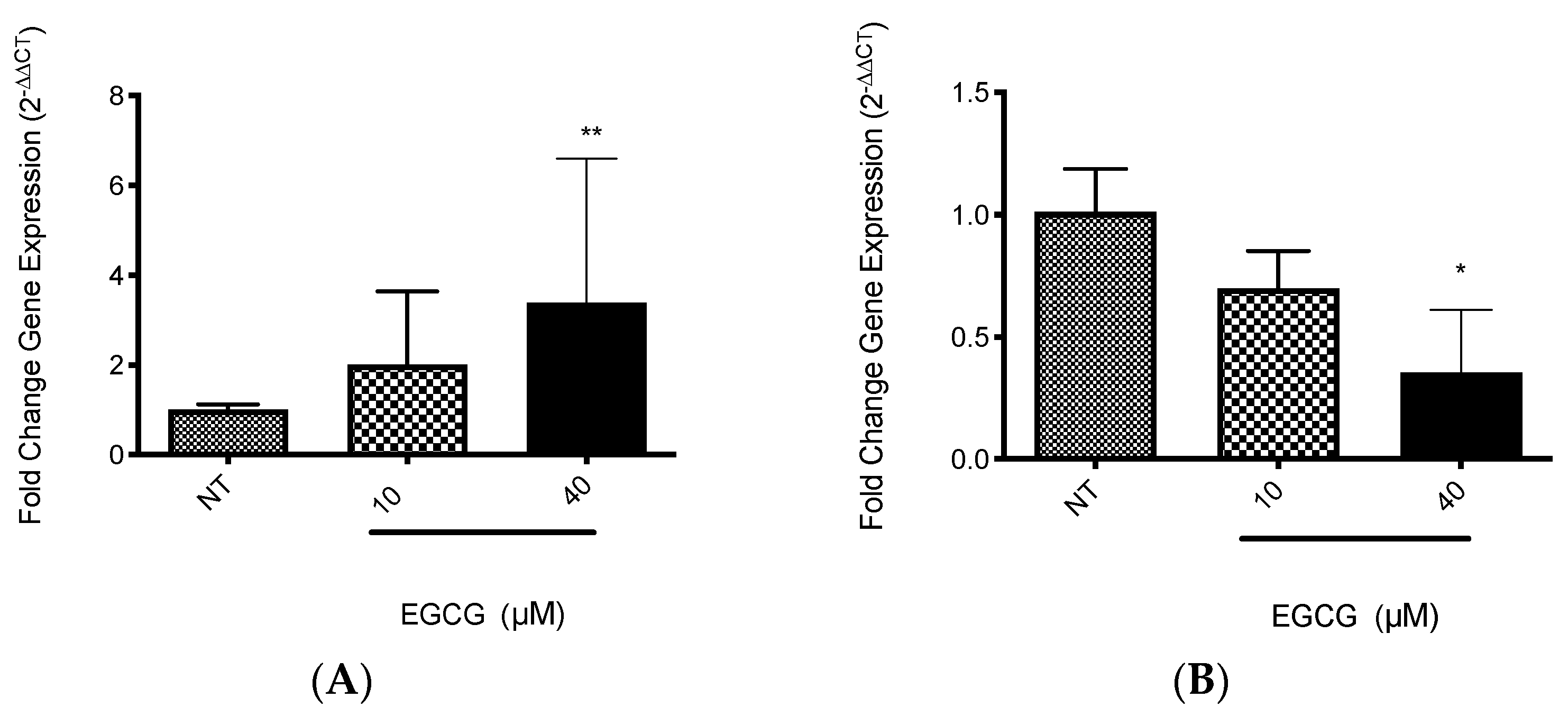
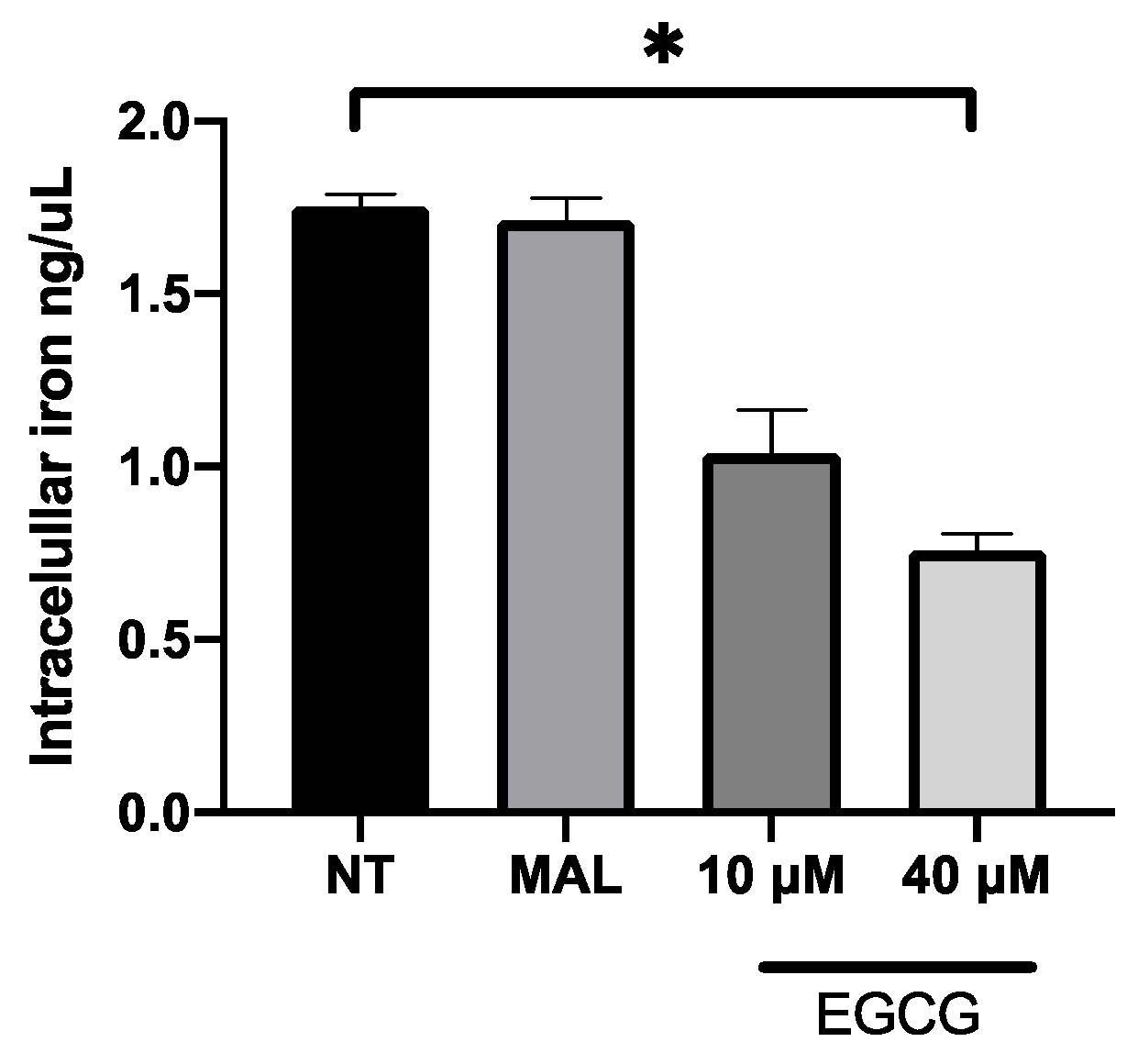
Disclaimer/Publisher’s Note: The statements, opinions and data contained in all publications are solely those of the individual author(s) and contributor(s) and not of MDPI and/or the editor(s). MDPI and/or the editor(s) disclaim responsibility for any injury to people or property resulting from any ideas, methods, instructions or products referred to in the content. |
© 2024 by the authors. Licensee MDPI, Basel, Switzerland. This article is an open access article distributed under the terms and conditions of the Creative Commons Attribution (CC BY) license (https://creativecommons.org/licenses/by/4.0/).
Share and Cite
León, D.; Reyes, M.E.; Weber, H.; Gutiérrez, Á.; Tapia, C.; Silva, R.; Viscarra, T.; Buchegger, K.; Ili, C.; Brebi, P. In Vitro Effect of Epigallocatechin Gallate on Heme Synthesis Pathway and Protoporphyrin IX Production. Int. J. Mol. Sci. 2024, 25, 8683. https://doi.org/10.3390/ijms25168683
León D, Reyes ME, Weber H, Gutiérrez Á, Tapia C, Silva R, Viscarra T, Buchegger K, Ili C, Brebi P. In Vitro Effect of Epigallocatechin Gallate on Heme Synthesis Pathway and Protoporphyrin IX Production. International Journal of Molecular Sciences. 2024; 25(16):8683. https://doi.org/10.3390/ijms25168683
Chicago/Turabian StyleLeón, Daniela, María Elena Reyes, Helga Weber, Álvaro Gutiérrez, Claudio Tapia, Ramón Silva, Tamara Viscarra, Kurt Buchegger, Carmen Ili, and Priscilla Brebi. 2024. "In Vitro Effect of Epigallocatechin Gallate on Heme Synthesis Pathway and Protoporphyrin IX Production" International Journal of Molecular Sciences 25, no. 16: 8683. https://doi.org/10.3390/ijms25168683
APA StyleLeón, D., Reyes, M. E., Weber, H., Gutiérrez, Á., Tapia, C., Silva, R., Viscarra, T., Buchegger, K., Ili, C., & Brebi, P. (2024). In Vitro Effect of Epigallocatechin Gallate on Heme Synthesis Pathway and Protoporphyrin IX Production. International Journal of Molecular Sciences, 25(16), 8683. https://doi.org/10.3390/ijms25168683







